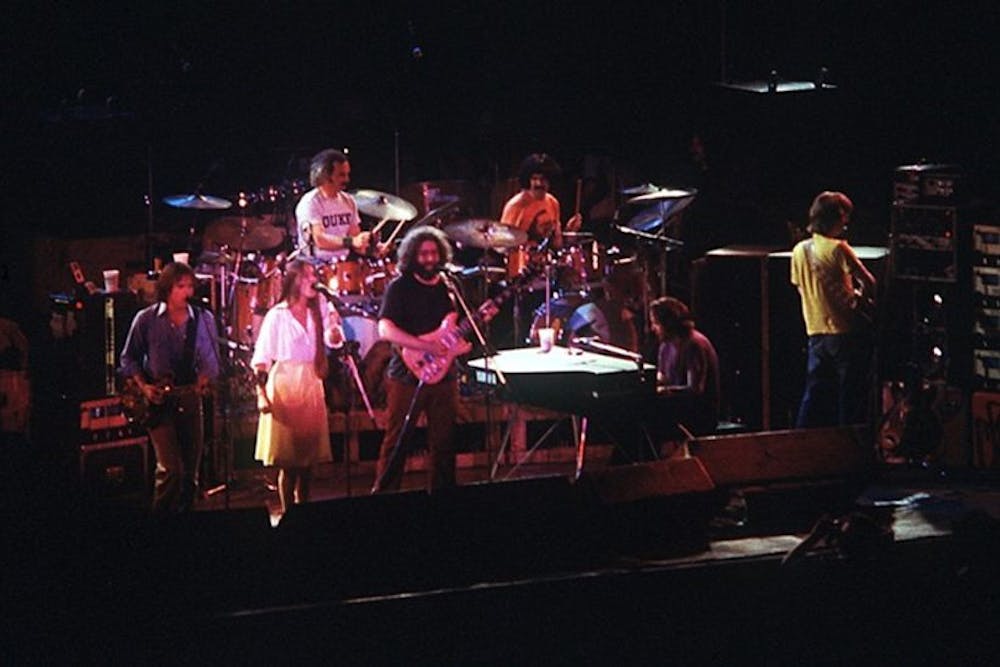Known for their eclectic genre-blending musical style, the Grateful Dead are legends of improvised live performances and a countercultural symbol of the 60s. Pioneering extended jam scenes, the Dead have cultivated dedicated fans, known as the “Deadheads”, across the world and continue to influence popular culture to this day.
The Dead have a unique relationship with Duke, which resulted in them performing on campus five times between 1971 and 1982. “The Good Ol’ Grateful Deadcast,” the official Grateful Dead podcast, explores the music and mythology of the Grateful Dead. Their newest episode explores both past and present factors that shaped the intertwined fates of Duke and the Dead.
Why does the Dead have such strong ties to Duke? Starting with an active fan-base in California and northeastern states like New York, the Dead worked to expand their influence into new areas. The band toured Virginia and Florida, yet their southern strategy halted as the regions didn’t evolve their own “hippie ballrooms to match the northeast, midwest and west coast,” the podcast host said.
However, the student union’s power led to the Dead’s first performance at Duke, which took place in April 1971 in Wallace Wade Stadium. The answer to what convinced them to come back four more times can be traced back to Peter Coyle, a former Duke University Union Coordinator and a co-founder of Duke Freewater Productions, who played a major role in organizing the Dead’s first show at Duke and stayed involved in the DUU programming committee.
According to Coyle, bands usually pick Greensboro Coliseum as their first choice when coming to North Carolina, as it is specifically for live music, while Cameron Indoor Stadium is known for hosting basketball games. Because of this, Duke was an unusual choice, yet the 1978 show at Cameron, surprisingly, has an incredible legacy: it is considered as the best of the Dead’s shows at Duke and one of the best of their overall performances.
In 1978, Raleigh was a “dead place.” According to Joe DiMona (Trinity ’81), a former Chronicle reporter, Durham was a “small southern town” without today’s Research Triangle Park, and Duke’s party scene boiled down to disco and beer. Fans of the Dead at Duke mostly came from New York, which was the second largest domestic source of students at the time, after North Carolina.
The Dead’s trip to campus brought an outpouring of high energy. Students recounted that their friends who were not in town – some Duke-affiliated, some not – drove down in order to see the Dead. It was an unprecedented vibrant scene at Cameron, which was considered an insignificant spot for music performances. People camped out for the tickets — eight years before tenting became a feature of Duke Basketball, according to Coyle.
This concert was, according to DiMona, the only event that generated such a close-knit community at Duke besides the basketball games. Over 350 people waited all night to get the best seats they could. Seating 8000 people, Cameron is a “large and intimate” space, DiMona said, and the students inside created high spirits that encouraged the Grateful Dead to come back again and again.
One significant feature of the Dead’s ’78 concert was the extended jam sequences. Deadcast took the audience into a close reading of “It Must Have Been The Roses” and then zoomed into the jam session in “Rhythm Devils,” which started with an unusually fast pace. Drummer Bill Kreutzmann created a rhythmic peak in the jam session, while guest percussionist Leonard “Cy” Kosis, the band’s chef, added a creative flair by playing pots and pans alongside the regular percussions. The Duke session of “Rhythm Devils” ended up the longest version filled with electrifying energy.
The Dead and campus organizations went above and beyond to foster engagement at the show. According to Coyle, WUDBS (now radio station WXDU) got tapes of the Dead’s music, and circulated them across Duke, building a larger fanbase at the university.
On the concert night, Freewater Productions set up cameras for the whole show, streaming it on television. Jerry Garcia’s voice sounds quiet in the official recording, yet his voice was loud and clear in the audience’s live recording, due to the special mixes the team implemented.
The Dead continues to be part of Duke until today, despite the stigma they once faced from the southern college community. At Duke, staff positively promotes the Dead’s legacy through academic courses for first-year students. Eric Mlyn, a Deadhead and a distinguished faculty fellow at the Kenan Institute, teaches materials on the Dead for the “What Now?” first-year seminar series.
Duke also commemorated the 45th anniversary of the Dead’s Cameron concert through panel discussions with Mlyn and Coyle in Spring 2023. The Dead not only mobilized Duke’s student body with their rich musical legacy, but their spirit continues to resonate within the community, just as powerfully as it did in the 1970s. Their enduring influence reminds us that the connection between Duke and the Dead is very much still alive today.
Get The Chronicle straight to your inbox
Sign up for our weekly newsletter. Cancel at any time.
Tina Qian is a Trinity sophomore and an arts editor for Recess.

